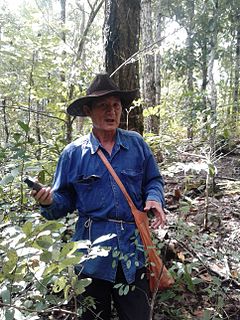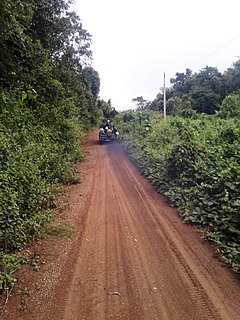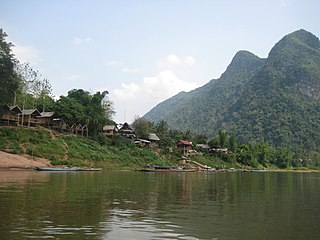 W
WBan Phanom is a village in Luang Prabang Province, Laos. It is located 6 kilometres (3.7 mi) east of Luang Prabang. The Lue peoples of this village are noted in particular for their cotton and silk weaving. Sale to tourists is now of prime importance to the local economy. Nearby is the Tomb of Mouhot, where Henri Mouhot lies.
 W
WBan Thapene is a village of Luang Prabang District, Luang Prabang Province, Laos. The village was first established about 130 years ago by Kha Hok families, one of the Khmu ethnic sub-groups. Like many other upland inhabitants in Luang Prabang, the livelihood and culture of ethnic groups such as Lao Loum, Kha Hok, Yao and Hmong in Ban Thapene is dependent on natural resources.
 W
WBan Xang Khong or Ban Sang Khong is a village in Luang Prabang Province, Laos. It is located about 5 kilometres (3.1 mi) east of Luang Prabang. The Lue peoples of this village are noted in particular for their arts and crafts. The locals are adept at making traditional Saa paper, which is made from mulberry trees. There are several bamboo bridges in the area, and the village can be approached on foot from Luang Prabang.
 W
WBan Yang is a village in Luang Prabang district, Luang Prabang province, Laos. It was established around 1935 by Lao Loum ethnic group who used to live in Ban Pha Quang village in Phu Phang Mountain. Ban Pha Quang village is 20 kilometers northeast from Mueang Nan district, Luang Prabang province. When they arrived, they saw this region had immense forested mountain, fertile land, abundant water source in the Huoi Sieu stream, and was convenient for living and farming. They also discovered a big tree with its roots crossing the Huoi Sieu stream like a bridge. The tree root that later was named as Yang, means 'crossing the stream'. Since then, people have called this village Ban Yang.
 W
WKhokmanh or Ban Khokmanh is a village in Mueang Luang Prabang, Khoueng Luang Prabang in Laos.
 W
WLuang Phabang, or Louangphabang, commonly transliterated into Western languages from the pre-1975 Lao spelling ຫຼວງພຣະບາງ as Luang Prabang, literally meaning "Royal Buddha Image", is a city in north central Laos, consisting of 58 adjacent villages, of which 33 comprise the UNESCO Town Of Luang Prabang World Heritage Site. It was listed in 1995 for unique and "remarkably" well preserved architectural, religious and cultural heritage, a blend of the rural and urban developments over several centuries, including the French colonial influences during the 19th and 20th centuries.
 W
WMuang Ngoi Neua is a Lao town along the Nam Ou in Louangphrabang Province. It is part of Ngoi district 170 kilometres North-East of Luang Prabang.
 W
WNong Khiaw, is a village in the Laotian province of Luang Prabang.